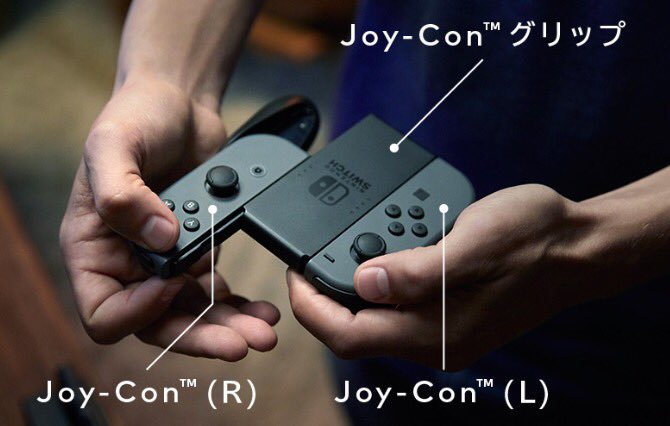Nuvendil said:
Ok, I will direct you to look at my direct response to the first response for most of the refutations or clarifications I can provide, I'm not going to put up another wall of text of that size :P I will provide some counter points. For one, the analogue sticks on the Switch are nothing like, say, the Vita. They are full analogue sticks like on your standard machine, at least as large as the PS4's. See here:
Those are not going in your pocket or a standard purse or satchel. Second, you are using the metrics of all mobiles to go against a handheld device. For one, handhelds are their own beast (explained in the post I refered you to) and are conventionally pocketable, that was my point. This one is larger than a phone, considerably, and thicker too. It's not just uncomfortable like the 3DS XL, pocketing it looks to be physically impossible. And with the Joy Cons, it is. Plus, pocketing it with the Joy Cons could damage it, that's a major fail in handheld design. But as I explained in my other post, this isn't a line in the sand, just a guiding principle that is unwise to depart from for a handheld. Third, the point of the active cooling is it further compromises the handheld aspect to boost the console aspect. No handheld - or mobile for that matter - would compromise the integrety of the frame for more performance via active cooling. Cause that limits where it can be put to a more dedicated or larger bag and adds the issue of heat coming off the device. Fourth, I contend the Joy Con's full feature set is most realized in the Grip accessory which almost certainly comes with the console to facilitate livingroom gaming. They are controllers that can be attatched if need be for the convenience of portable play if desired. And most importantly, my point was that if you lose your Joy Cons, no more Switch play. You must have those external peripherals in order to use the device. A handheld has the whole system as one piece, period. And plus, if you leave the Joy Cons attached, the portability aspect of handheld design is compromised further. Again, a console function orriented feature included at the detriment of the handheld functionality. Fifth, the inclusion of same-system integrated multiplayer is a major console feature because adhering to good handheld design - that is, requiring no controllers due to integrated controls and also restricting the size of the system - precludes that feature completely. Only by violating good handheld design can the system have that feature completely integrated. So to conclude, my argument is that, while it has a similar form factor to a tablet or handheld, it has many design decisions that run directly contrary to good handheld design sense. The size and joy-con design violates the ain of maximum convenience in portability (very convenient for a console, not convenient at all by a handheld or even mobile device standard), the active cooling compromises the internal structural integrity and adds heat to the list of ways the system sacrifices that maximum convenience of portability for more power while also violating the battery-conscious design principle that is important to handhelds and mobiles, the absolute need for (and thus losable) separate peripherals (which again, can't be kept attached to the system while storing in 90% of bags and 100% of pockets and therefore must frequently be attached) violates the all-in-one design principle of handhelds. And the use of that last decision (need for, inclusion of, and support for multiple external peripherals) to allow same-system multiplayer is a very console-minded decision that comes at the expense of good handheld design. Hopefully that plus the other post in response to the other guys response to my first post explains my whole point clearly :P |
I actually don't disagree with all of your points. Like I said, I come to the opposite conclusion. Where you see the controls (I disagree here, as they are much smaller than any standard thumbsticks) as proving your point, I see that that are quite compromised for use as individual controls in a "console" setting with TWO players(which you claimed was the reason for it being a console).
Most of your design call outs show that Nintendo clearly wanted to take the handheld and give it console like features to try and get a piece of both markets. Because we al lack any real hands on or even non PR video of the device, we have to make a few assumptions. It seams clear that the device will have sacrificed some of its portability features to give it console features and likewise it will have many sacrifices to console features to make it portable. To me, it fails to make a good to great console experience based on todays standards: 1. power 2. quality of controllers out of the box 3. HD/4k capability(this is a device coming out in 2017) 4. internal storage (not enough in todays world for digital downloads of games) . Had the switch came out with even an equal amount of these features to a basic XB1(released almost 4 years ago), I would have agreed that it was a console. Because it didnt, I can't even consider it to be a true console(unles you are talking retro!). The only real compromise to its handheld capabilities are its general size for carrying. Poor batterylife isn't uncommon nowadays.
No need for us to continue to trade explanations. We just end up on different perceptions of what the features and design result in. Either way, I am looking forward to it having many more features and capabilities than already shown. I am just worried that as a jack of all trades, it proves to be a master of none.
It is near the end of the end....

















